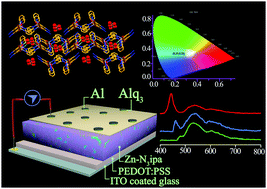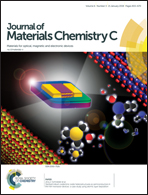Pure white light emission from a rare earth-free intrinsic metal–organic framework and its application in a WLED†
Abstract
Metal–organic frameworks are a class of porous materials where the metal centre is attached to other anionic or neutral ligands for extension into 1D, 2D or 3D framework. Since the discovery of light-emitting metal–organic frameworks (MOFs), many efforts have been made to achieve white light emission.To date, most of the white light-emitting MOFs that are available in the literature are based on rare earth metal doping or encapsulation of some luminescent dye molecules or other inorganic complexes within the pores of MOF, such that the collective luminescence covers the whole visible region. However, white light emission from a non rare earth-based single MOF is still unexplored and desirable because of low power consumption, lower manufacturing costs, and environmental safety purposes. In the present study, a zinc-based MOF was synthesized, which showed white light emission with a CIE index of (0.31, 0.33) upon excitation at 260 nm, and the corresponding quantum yield was about 32.5%. The white emission arises due to three peaks, among which two peaks at 384 nm and 468 nm originate from π–π* and n–π* transitions of N3-ipa, respectively, and the new peak at 570 nm is due to the charge transfer phenomenon from the pyridine moiety to the linker. DFT calculations were carried out to estimate the energy levels of the MOF, and all the peaks in PL spectra were well explained using the DFT study. Finally, a light-emitting diode was fabricated using the MOF as the active material, which showed white electroluminescence spectra. An energy band diagram based on the DFT calculation is also presented to understand the origin of white photoluminescence and electroluminescence from this MOF-based light-emitting diode.



 Please wait while we load your content...
Please wait while we load your content...